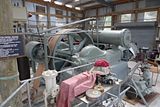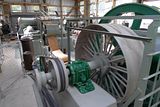8 years ago, my wife and I moved to Kelowna from an area east of here known as the 'Kootenays'. There's two Kootenays, East and West each with their own rich mining history. Metals (gold, silver, copper, lead, zinc) in the west, and Coal in the east. Except for the enormous open pit coal mines of the East Kootenays, most of the mines are a fading memory.
While trees make up most of the scenery of the 4 hour trip 'back home', there are a few little towns along the way. The one of interest to this post is the 'city' of Greenwood, population 656. This town is situated among the ruins of a copper smelter, the smoke stack and black tailings pile still play a very prominent role in the local scenery.
Sitting in a rough field in what I assume is a park, as there is playground equipment near by, are a few machines. After 8 years of driving by, I finally decided to stop and take a look:


The larger machine is an Ingersoll Rand Type 10 compressor. I didn't think to take a photo of the other side of the smaller machine where the descriptive marks were. It is manufactured by Ingersoll Rand as well. From reading here, I see that the Type 10 is not a rare piece of machinery; in fact, our own Rick Rowlands has one in preservation.
I have a few questions:
1. Does the type 10 run on steam, or is it externally driven?
2. Somewhat related to the first question, why would a generator be belted to a compressor? The piece of electrical equipment is a Westinghouse 3 phase AC generator, 236 A, 440 V.
3. What is the smaller Ingersoll Rand machine? I'm assuming some sort of compressor as well...
While trees make up most of the scenery of the 4 hour trip 'back home', there are a few little towns along the way. The one of interest to this post is the 'city' of Greenwood, population 656. This town is situated among the ruins of a copper smelter, the smoke stack and black tailings pile still play a very prominent role in the local scenery.
Sitting in a rough field in what I assume is a park, as there is playground equipment near by, are a few machines. After 8 years of driving by, I finally decided to stop and take a look:


The larger machine is an Ingersoll Rand Type 10 compressor. I didn't think to take a photo of the other side of the smaller machine where the descriptive marks were. It is manufactured by Ingersoll Rand as well. From reading here, I see that the Type 10 is not a rare piece of machinery; in fact, our own Rick Rowlands has one in preservation.
I have a few questions:
1. Does the type 10 run on steam, or is it externally driven?
2. Somewhat related to the first question, why would a generator be belted to a compressor? The piece of electrical equipment is a Westinghouse 3 phase AC generator, 236 A, 440 V.
3. What is the smaller Ingersoll Rand machine? I'm assuming some sort of compressor as well...




